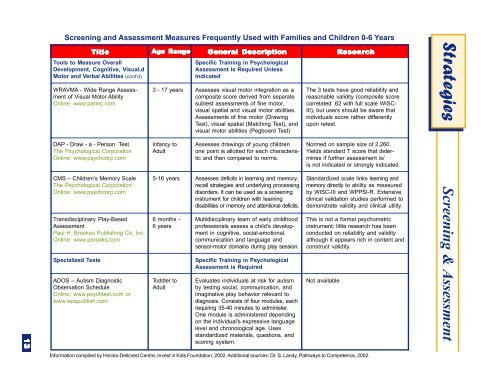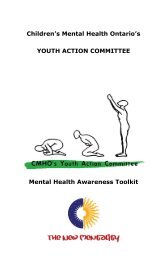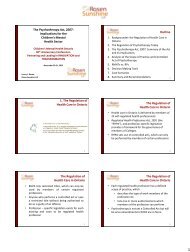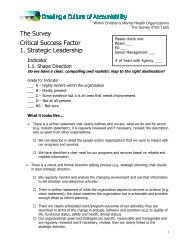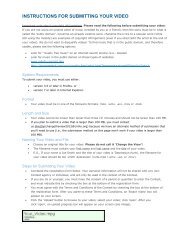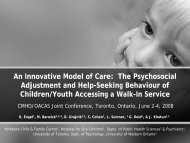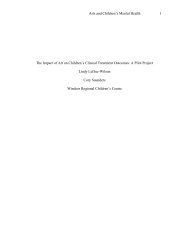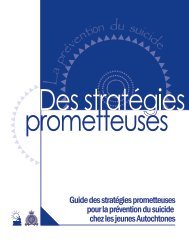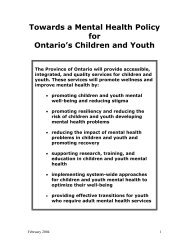Early Childhood Mental Health Treatment: Training Reference Guide
Early Childhood Mental Health Treatment: Training Reference Guide
Early Childhood Mental Health Treatment: Training Reference Guide
You also want an ePaper? Increase the reach of your titles
YUMPU automatically turns print PDFs into web optimized ePapers that Google loves.
13<br />
Screening and Assessment Measures Frequently Used with Families and Children 0-6 Years<br />
Title<br />
Tools to Measure Overall<br />
Development, Cognitive, Visual,d<br />
Motor and Verbal Abilities (cont’d)<br />
WRAVMA - Wide Range Assessment<br />
of Visual Motor Ability<br />
Online: www.parinc.com<br />
DAP - Draw - a - Person Test<br />
The Psychological Corporation<br />
Online: www.psychcorp.com<br />
CMS – Children’s Memory Scale<br />
The Psychological Corporation<br />
Online: www.psychcorp.com<br />
Transdisciplinary Play-Based<br />
Assessment<br />
Paul H. Brookes Publishing Co. Inc.<br />
Online: www.pbrooks.com<br />
Specialized Tests<br />
ADOS – Autism Diagnostic<br />
Observation Schedule<br />
Online: www.psychtest.com or<br />
www.wpspublish.com<br />
Age Range<br />
3 - 17 years<br />
Infancy to<br />
Adult<br />
5-16 years<br />
6 months -<br />
6 years<br />
Toddler to<br />
Adult<br />
General Description<br />
Specific <strong>Training</strong> in Psychological<br />
Assessment is Required Unless<br />
Indicated<br />
Assesses visual motor integration as a<br />
composite score derived from separate<br />
subtest assessments of fine motor,<br />
visual spatial and visual motor abilities.<br />
Assessments of fine motor (Drawing<br />
Test), visual spatial (Matching Test), and<br />
visual motor abilities (Pegboard Test)<br />
Assesses drawings of young children<br />
one point is allotted for each characteristic<br />
and then compared to norms.<br />
Assesses deficits in learning and memory,<br />
recall strategies and underlying processing<br />
disorders. It can be used as a screening<br />
instrument for children with learning<br />
disabilities or memory and attentional deficits.<br />
Multidisciplinary team of early childhood<br />
professionals assess a child’s development<br />
in cognitive, social-emotional,<br />
communication and language and<br />
sensor-motor domains during play session.<br />
Specific <strong>Training</strong> in Psychological<br />
Assessment is Required<br />
Evaluates individuals at risk for autism<br />
by testing social, communication, and<br />
imaginative play behavior relevant to<br />
diagnosis. Consists of four modules, each<br />
requiring 35-40 minutes to administer.<br />
One module is administered depending<br />
on the individual’s expressive language<br />
level and chronological age. Uses<br />
standardized materials, questions, and<br />
scoring system.<br />
Resear<br />
esearch<br />
The 3 tests have good reliability and<br />
reasonable validity (composite score<br />
correlated .62 with full scale WISC-<br />
III), but users should be aware that<br />
individuals score rather differently<br />
upon retest.<br />
Normed on sample size of 2,260.<br />
Yields standard T score that determines<br />
if further assessment is/<br />
is not indicated or strongly indicated.<br />
Standardized scale links learning and<br />
memory directly to ability as measured<br />
by WISC-III and WPPSI-R. Extensive<br />
clinical validation studies performed to<br />
demonstrate validity and clinical utility.<br />
This is not a formal psychometric<br />
instrument; little research has been<br />
conducted on reliability and validity<br />
although it appears rich in content and<br />
construct validity.<br />
Not available<br />
Information compiled by Hincks-Dellcrest Centre, Invest in Kids Foundation, 2002. Additional sources: Dr. S. Landy, Pathways to Competence, 2002.<br />
Strategies Screening & Assessment


